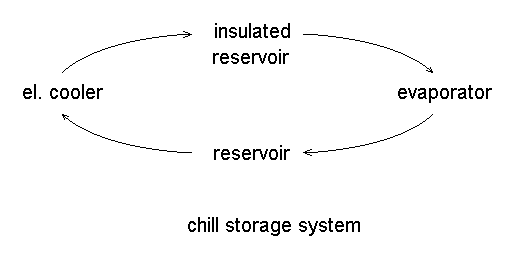Two reservoirs are not always required, in some cases the same reservoir can be used. If ice is produced, an evaporator is not always necessary; for air-conditioning, the air is cooled enough by flowing through the reservoir.

Thermal energy storage (TES) involves both heating and cooling energy.
A heating TES add heat to a storage medium, a cooling TES extracts heat from a
storage medium, which is stored in a reservoir.
Cool TES systems are used e.g. for air-conditioning: At night inexpensive
off-peak power is used to create a reservoir of cool material, and during
the day the reservoir is tapped to provide cooling capacity.
| Storage medium | Capacity(40K) | Note | |
|---|---|---|---|
| Ice | 334,000 J/kg | 144 Btu/pound | + for low temperatures + low space requirement |
| Chilled water | 40,000 J/kg | 18 Btu/pound | o for conventional temperatures - high space requirement |
| Phase-change | 160,000 J/kg | 60 Btu/pound | o for conventional temperatures + low space requirement |
Btu=British thermal unit
Phase-change material systems are more expensive than chilled water sytems,
but they are easy to maintain and need less space.
The storage medium is cooled in the cooler and stored in the insulated
reservoir for later use. When cooling is needed, the evaporator produces
it by tapping the reservoir.
Two reservoirs are not always required, in some cases the same reservoir
can be used. If ice is produced, an evaporator is not always necessary;
for air-conditioning, the air is cooled enough by flowing through the reservoir.
